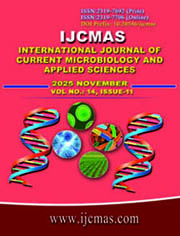


 National Academy of Agricultural Sciences (NAAS)
National Academy of Agricultural Sciences (NAAS)

|
PRINT ISSN : 2319-7692
Online ISSN : 2319-7706 Issues : 12 per year Publisher : Excellent Publishers Email : editorijcmas@gmail.com / submit@ijcmas.com Editor-in-chief: Dr.M.Prakash Index Copernicus ICV 2018: 95.39 NAAS RATING 2020: 5.38 |
Poultry farming is an important economic activity practiced by the majority of Nigeriens, but its growth remains relatively fragile due to health aspects. The objective of this study is to assess breeding practices and potential microbiological risks in poultry farms in the Niamey region. To do this, a survey was conducted from June to October 2024. Samples of food, water and droppings were taken. The results of this study identify several poultry farming practices, including breeding, broiler farming, egg production and mixed strain farming. Although the majority of farms use organic cage and feed farming. In fact, 60% do not comply with isolation standards and do not monitor internal movements. Regarding input management, few farms control the feeding of chicks. As for bedding, 60% of farms have set it up and 80% clean the feeders daily. However, more than half of the corpses are occasionally collected and cremated. The results of the farm analysis show a high level of microbial contamination of the food, with E. coli measured at 1.40±2.20.106 CFU/g and fecal coliforms at 4.23±0.78.106 CFU/g, exceeding the standard of 99 CFU/g. Water samples also revealed high levels of E. coli at 2.72±3.14.104 CFU/g and CF at 4.80±5.54.106 CFU/g, exceeding the standards of 0 CFU/g for CT and 50 CFU/g for CF. The cloaca swabs show 4.13±4.77.107 CFU/g for E. coli and 3.63±4.19.106 CFU/g for CF, while the droppings samples show 5.37±0.10.107 CFU/g for E. coli and 2.49±4.32.108 CFU/g for CF, exceeding the standard of 5103 CFU. Salmonella spp. contamination is observed in 60% of farms. This underscores the importance of raising farmers' awareness of biosecurity measures and microbiological risks related to poultry farming and the development of microbiological standards in poultry farms.
Abdelkader. C.Z et Abdenour. T.K (2019). La biosécurité en élevage avicole. Projet de fin d’étude. République Algérienne Université Saad Dahlab-Blida1-. 53p. Disponible sur https://di.univ-blida.dz
Amadou. M B., Idi A. & Benabdeljelil K. (2010). Aviculture familiale rurale au Niger : alimentation et performances zootechniques. Rapports de Recherche. Communications en Aviculture Familiale. Vol. 19, N°1. 50p.Disponible sur AMCRA (Antimicrobial Consumption and Resistance in Animals). 2013. Guide Sanitaire pour les Élevages Avicoles (1ère édn). AMCRA. http://www.amcra.be
Bansé Ouedraogo, Bayala Bale, Sibiri-Jean Zoundi, Laya Sawadogo (2015). Caractéristiques de l’aviculture villageoise et influence des techniques d’amélioration sur les performances zootechniques dans la province du sourou, région nord-ouest burkinabè. Int. J. Biol. Chem. Sci. 9 : 1528-1543.http://dx.doi.org/10.4314/ijbcs.v9i3.34.
Bebay C-E. 2006. Première évaluation de la structure et de l'importance du secteur avicole commercial et familial en Afrique de l'Ouest. Food and Agriculture Organization.
Brah N., Houndonougbo F.M., Issa, S. ET Chrysostome, C. A. A. M. (2019). Tableur Ouest Africain de Formulation d’Aliments de Volailles (TOAFA-Volaille). International Journal of Biological and Chemical Sciences. 13(3):1308-1320 p. DOI: https://dx.doi.org/10.4314/ijbcs.v13i3.8
Dosso Sinaly (2014). Analyse des pratiques avicoles et de l’usage des antibiotiques en aviculture moderne dans le département d’agnibilekrou (cote d’ivoire) thèse de docteur en médecine vétérinaire, université cheikh Anta Diop de dakar. 152p. Disponible sur beep@ird.fr
Drouin P. 2000. Les principes de l'hygiène en productions avicoles. Sciences et Techniques Avicoles, 11-14. https://beep.ird.fr
INS (2023). [En ligne] Statistiques de l'Elevage (Consulté le 15-10- 2025), disponible sur : https://stat-niger.org/ https://niger.opendataforafrica.org/wvovabg/statistiques-de-l-elevage?lang=fr
Kouadio et al., 2013. Influence du système d’élevage sur la reproduction de la poule locale Gallus domesticus, Cote d’Ivoire Journal of Applied Biosciences 72:5830– 5837
Le 360 Afrique (2024). [en ligne] Séminaire de la volaille de Niamey : pour que l’aviculture vole de ses propres ailes, (consulté le 15/10/2025) disponible sur: https://afrique.le360.ma/economie/semaine-de-la-volaille-de-niamey-pour-que-laviculture-vole-de-ses-propres-ailes_V47DGN3Y6VF7JDRWC5LXVYHG6A/
N’Guessan Yiwo Thècle Noée Céline (2009). Pratiques de biosécurité et risques biologiques potentiels dans les élevages avicoles à agnibilekrou et en zones periurbaines d’abidjan). Thèse de docteur vétérinaire, université cheikh Anta Diop de Dakar. 120p. Disponible sur https://www.beep.ird.fr
Oulon Elise (2010). Etat des lieux sur les mesures de biosécurités dans les fermes avicoles au Sénégal : cas des départements de Rufisque et Thiès thèse de docteur en médecine vétérinaire (diplôme d’état), université cheikh Anta Diop de dakar.125p. Disponible sur https://www.beep.ird.fr
Vidogbena F., Adégbidi A., Garnett S., Koudandé D., Agbo V. and Zander K. (2010) Peace, health or fortune? Preferences for chicken traits in rural Benin, Ecological Economics 69(9), 1848-1857. |
 |
 |
 |
 |